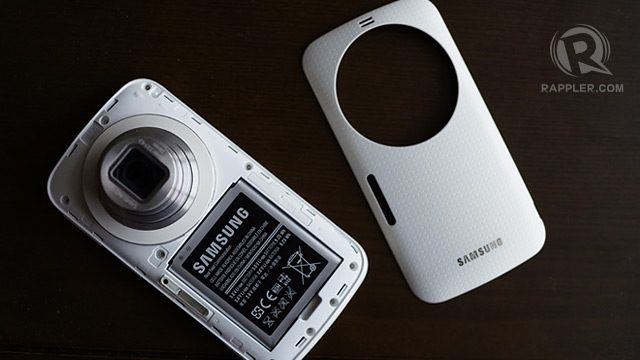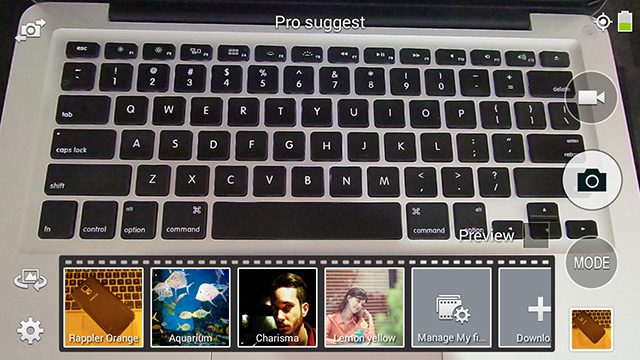SUMMARY
This is AI generated summarization, which may have errors. For context, always refer to the full article.

SINGAPORE – Not a company traditionally known as a leader in the digital imaging space, South Korea-based Samsung finds itself strategically positioned to redefine a new age of photography at a time where capturing and sharing moments has never been more ubiquitous.
The shift is consumer driven, moving away from bulky Digital Single Lens Reflex (DSLR) cameras to more compact devices like pocket cameras and smartphones – a market that Samsung currently dominates.
The expectations however are the same, if not even higher. Like how the Internet has democratized publishing, consumer devices have also made it easier for anyone to create high quality content, and in this case, shoot amazing photographs.
Samsung, because it can afford to, takes on this challenge and then some with a new mantra to meet not only the requirements of the everyday consumer but also even niche audiences.
Digital camera to smartphone camera
In Samsung’s world there are cameras for at least 3 main types of user – those needing the flexibility of interchangeable lenses (NX30, NX300, NX mini); those looking for data-enabled Android cameras (Galaxy NX, Galaxy Camera 2); and those who don’t want to have to carry both a camera and a smartphone and prioritize the latter (Galaxy S5).
Smartphone-based digital imaging seems to be where there is most potential and where major players are casting their bets. But the world’s largest smartphone manufacturer faces fierce competition from the likes of Apple, HTC, LG, Nokia and Sony. It’s a one-upmanship that is less about megapixels and more about image sensor size and the ability to take photos with depth of field.
For its part Samsung has pushed the envelope – its flagship Galaxy S5 smartphone has both phase and contrast detection autofocus, high-end camera functionality that gives the S5 insanely fast autofocus speeds.
Last year it also introduced the Galaxy S4 Zoom, the world’s first smartphone with an optical zoom lens. This year Samsung is giving the product a refresh, marketing it under a new name, the Galaxy K Zoom.
The K Zoom
As much as Samsung wants you to think it’s different, the Galaxy K Zoom for all intents and purposes is very much an update to the S4 Zoom. Smartphone first, camera second, designed specifically for niche users who want a zoom lens.
The K Zoom sports a 10x optical zoom lens with optical image stabilization (OIS) that can go from a focal length of 24mm to 240mm in a little over a second.
And while the average food pic or selfie won’t require any zoom at all there are real life events where zoom comes in handy like school plays, graduation ceremonies, sporting events, concerts and when traveling.


Design and construction

The S4 clearly was a mashup between two devices. Face up, the phone was identical to the S4 mini smartphone but when turned around it was undeniably a camera.
This isn’t the case with the K Zoom. In fact Samsung did everything it could to make it look more like a phone than a camera. Gone is the camera grip and built in tripod mount. The lens, while still unmistakable, now protrudes ever so slightly thanks to a retracting lens system that stores one group of elements to the side of the lens when the camera is not in use.

Samsung is also turning to faux leather to address the biggest complaint about the plasticky build of its products. Like all of its devices that got make-overs this year, the K Zoom comes with a removable leather-like back plate with the same dimpled pattern and aluminum looking plastic trim as the S5, all part and parcel of a design trend Samsung is calling “modern glam.”
The back plates are available in blue, black and white.

Up front though it still is very much familiar territory. Save for a third of an inch, the K Zoom is pretty much the S5. Its 4.8-inch display (up from 4.3-inches) gives the phone a bigger profile but it is noticeably thinner and most definitely more pocketable and ergonomic.
Software
The K Zoom runs the latest version of Android, 4.4.2 KitKat with Samsung’s updated TouchWiz interface. All the same software enhancements available on the S5 are also on the device including My Magazine which is still a swipe to the right from the home screen, there’s also ultra power saving mode, a scaled down version of S Health and support for the Google Now widget that actively listens for voice commands.
Samsung also kept the user interface on its 2014 camera lineup pretty much consistent.

On the K Zoom, like the S5, the camera app has the standard 3 button layout on the right – with buttons for shooting video, shooting photos, and switching between SMART modes. The settings menu is also familiar, expandable when shooting in Manual Mode with dials for exposure and white balance similar to the interface on the NX mini.

Two new camera features stand out. The first is called AF/AE Separation, similar to a feature on the ZTE Nubia 5S which debuted at CES 2014 in Las Vegas users can now select separate focus and exposure points when composing photos. To separate AF and AE points, tap on the screen to focus, then drag the white corner away from the bright green focus point.

Samsung is also touting a new mode called Pro Suggest. When selected, soft pressing on the shutter will bring up 5 filters that best match the lighting conditions, Samsung calls them films. Aside from those already built into the phone you can download new films from the Pro Suggest Marketplace and or create your own.



While it doesn’t have the finesse of Apple’s iTunes Store ecosystem, it’s refreshing to see users being given the power to create their own film packs without having to rely on third party developers. Samsung hopes more users will upload custom films that can be shared by the community.
Performance

The K Zoom is powered by a hexa-core processor made up of two 1.7GHz ARM A15 cores paired with four 1.3 GHz ARM A7 cores. While Samsung won’t say, from the looks of it, this is the Exynos 5260 which it announced at Mobile World Congress last February.
This combo is supposed to improve overall performance and consume power more efficiently – faster but easier on the batteries. Depending on complexity, tasks will either be assigned to the dual core processor (easy tasks) or the quad core processor (more processor intensive tasks). All six cores should be able to work simultaneously.
While we did not have enough time with the device to vouch for real world use, benchmarking results on benchmarking app Antutu were pretty impressive. The device scored a 30753 just a tad bit shy of the 34240 of the more higher specced Galaxy S5.
What’s in a name?

There has been a lot of comparison between the K Zoom and its predecessor the S4 Zoom, the obvious relation is one that Samsung wants to brush aside.
But the name change and the design direction signifies the intention to forge a new path for a new class of devices – smartphones still, but with cameras that can do more.
For all its quirks the K Zoom is a considerable upgrade over its predecessor. Usually it takes Samsung three tries to produce a hit, but on revision number two, one can appreciate at least, that it has clearly defined what kind product it wants the product to be – a smartphone with a specialized camera.
And so whether or not the K Zoom is successful, this clarity lays a good foundation for what’s ahead. Imagine smartphone cameras with imaging sensors that rivaled compact cameras, smartphones that could shoot great photo and video underwater, or smartphones with interchangeable lenses.
Gone are the days where the camera is just one of a cellphone’s many features, and by creating an all new “K” line, separate from its popular “S” line Samsung is telling us there is more in the pipeline. – Rappler.com
Add a comment
How does this make you feel?
There are no comments yet. Add your comment to start the conversation.